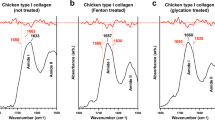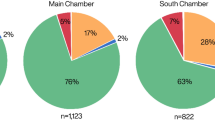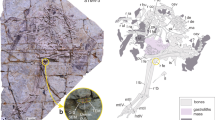Abstract
COLLAGEN has been found in mummified human remains several thousand years old, and in mastodon bones preserved under permafrost conditions. It has been stated that bone fragments after glacier preservation had all the appearances of a fresh bone1. Studies on Pleistocene bones have demonstrated that it is also possible to observe collagen and other organic materials in a fossil bone2,3. Electron micrographs of fossil bones of a deer-like animal from the Miocene (25 million years old) revealed collagen fibrils and the intact walls of canaliculi4. There have also been reports of striated muscle fibres, epithelial cells and melanophores being found in tissues of specimens from the Eocene (40 million years old) deposits of Geiseltal (eastern Germany)5. Furthermore, electron microscope investigations of patches of almost completely demineralized bone of a dinosaur from the Upper Trias (200 million years old), and the dermal armour of Devonian ostracoderms, have revealed a fibrillar structure, while a further examination of the same material showed a mixture of mineral and collagen patterns6. Analysis of fishes from the Middle Devonian (380 million years old) has indicated that degradation products of collagen can still be recognized. More recently7,8, it has been demonstrated that fossil dentine and bone-like tissues in Devonian ostracoderms can be decalcified and sectioned on a microtome. The presence in these tissues of polysaccharides as well as collagen has been indicated.
This is a preview of subscription content, access via your institution
Access options
Subscribe to this journal
Receive 51 print issues and online access
$199.00 per year
only $3.90 per issue
Buy this article
- Purchase on Springer Link
- Instant access to full article PDF
Prices may be subject to local taxes which are calculated during checkout
Similar content being viewed by others
References
Ezra, H. C., and Cook, S. F., Science, 129, 465 (1959).
Wyckoff, R. W. G., and Doberenz, A. R., Proc. U.S. Nat. Acad. Sci., 53, 230 (1965).
Wyckoff, R. W. G., Wagner, E., Matter, III, P., and Doberenz, A. R., Proc. U.S. Nat. Acad. Sci., 50, 215 (1963).
Little, K., Kelly, M., and Courts, A., J. Bone and Joint Surg., 44, B, 503 (1962).
Müller, A. H., Lehrb. d. Paläozool., Jena, 1, 109 (1957).
Isaacs, W. A., Little, K., Currey, J. D., and Tarlo, L. B., Nature, 197, 192 (1963).
Moss, M. L., Trans. N.Y. Acad. Sci., Ser. 2, 23, 495 (1961).
Tarlo, L. B., and Mercer, J. R., Proc. Geol. Soc. London, 127, 1590 (1961).
Kielan-Jaworowska, Z., Bull. Acad. Pol. Sci., Ser. biol., 4 (1966).
Author information
Authors and Affiliations
Rights and permissions
About this article
Cite this article
PAWLICKI, R., KORBEL, A. & KUBIAK, H. Cells, Collagen Fibrils and Vessels in Dinosaur Bone. Nature 211, 655–657 (1966). https://doi.org/10.1038/211655a0
Issue Date:
DOI: https://doi.org/10.1038/211655a0
This article is cited by
-
Confirmation of ovarian follicles in an enantiornithine (Aves) from the Jehol biota using soft tissue analyses
Communications Biology (2020)
-
Unusual intraosseous fossilized soft tissues from the Middle Triassic Nothosaurus bone
The Science of Nature (2017)
-
Fine structure of bone in dinosaurs, birds and mammals
Nature (2000)
-
Proteins in the fossil bone of the dinosaur, seismosaurus
Journal of Protein Chemistry (1991)
Comments
By submitting a comment you agree to abide by our Terms and Community Guidelines. If you find something abusive or that does not comply with our terms or guidelines please flag it as inappropriate.



